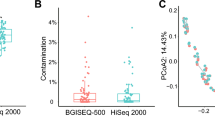Abstract
Improvements in technology and decreases in price have made de novo bacterial genomic sequencing a reality for many researchers, but it has created a need to evaluate the methods for generating a complete and accurate genome assembly. We sequenced the GC-rich Caulobacter henricii genome using the Illumina MiSeq, Roche 454, and Pacific Biosciences RS II sequencing systems. To generate a complete genome sequence, we performed assemblies using eight readily available programs and found that builds using the Illumina MiSeq and the Roche 454 data produced accurate yet numerous contigs. SPAdes performed the best followed by PANDAseq. In contrast, the Celera assembler produced a single genomic contig using the Pacific Biosciences data after error correction with the Illumina MiSeq data. In addition, we duplicated this build using the Pacific Biosciences data with HGAP2.0. The accuracy of these builds was verified by pulsed-field gel electrophoresis of genomic DNA cut with restriction enzymes.


Similar content being viewed by others
References
Bankevich A, Nurk S, Antipov D, Gurevich AA, Dvorkin M, Kulikov AS, Lesin VM, Nikolenko SI, Pham S, Prjibelski AD et al (2012) SPAdes: a new genome assembly algorithm and its applications to single-cell sequencing. J Comput Biol 19:455–477
Bartram AK, Lynch MD, Stearns JC, Moreno-Hagelsieb G, Neufeld JD (2011) Generation of Multimillion-Sequence 16S rRNA gene libraries from complex microbial communities by assembling paired-end illumina reads. Appl Environ Microbiol. 77:3846–3852
bio.biomedicine.gu.se/cutter2/. Accessed 2014
Chin CS, Alexander DH, Marks P, Klammer AA, Drake J, Heiner C, Clum A, Copeland A, Huddleston J, Eichler EE et al (2013) Nonhybrid, finished microbial genome assemblies from long-read SMRT sequencing data. Nat Methods 10:563–569
Consortium, T.H.M.P (2012) A framework for human microbiome research. Nature 486:215–221
Consortium, T.H.M.P (2012) Structure, function and diversity of the healthy human microbiome. Nature 486:207–214
Darling AE, Mau B, Perna NT (2010) ProgressiveMauve: multiple genome alignment with gene gain, loss and rearrangement. PLoS ONE 5:e11147
Ely B, Gerardot CJ (1988) Use of pulsed-field-gradient gel electrophoresis to construct a physical map of the Caulobacter crescentus genome. Gene 68:323–333
Fleischmann RD, Adams MD, White O, Clayton RA, Kirkness EF, Kerlavage AR, Bult CJ, Tomb JF, Dougherty BA, Merrick JM et al (1995) Whole-genome random sequencing and assembly of Haemophilus influenzae Rd. Science 269:496–512
Gurevich A, Saveliev V, Vyahhi N, Tesler G (2013) QUAST: quality assessment tool for genome assemblies. Bioinformatics 29:1072–1075
Jackman SD, Birol I (2010) Assembling genomes using short-read sequencing technology. Genome Biol 11:202
Koren S, Harhay GP, Smith TP, Bono JL, Harhay DM, McVey SD, Radune D, Bergman NH, Phillippy AM (2013) Reducing assembly complexity of microbial genomes with single-molecule sequencing. Genome Biol 14:R101
Magoc T, Pabinger S, Canzar S, Liu X, Su Q, Puiu D, Tallon LJ, Salzberg SL (2013) GAGE-B: an evaluation of genome assemblers for bacterial organisms. Bioinformatics 29:1718–1725
Margulies M, Egholm M, Altman WE, Attiya S, Bader JS, Bemben LA, Berka J, Braverman MS, Chen YJ, Chen Z et al (2005) Genome sequencing in microfabricated high-density picolitre reactors. Nature 437:376–380
Myers EW, Sutton GG, Delcher AL, Dew IM, Fasulo DP, Flanigan MJ, Kravitz SA, Mobarry CM, Reinert KH, Remington KA et al (2000) A whole-genome assembly of Drosophila. Science 287:2196–2204
Narzisi G, Mishra B (2011) Comparing de novo genome assembly: the long and short of it. PLoS ONE 6:e19175
Phillippy AM, Schatz MC, Pop M (2008) Genome assembly forensics: finding the elusive mis-assembly. Genome Biol 9:R55
Quail MA, Smith M, Coupland P, Otto TD, Harris SR, Connor TR, Bertoni A, Swerdlow HP, Gu Y (2012) A tale of three next generation sequencing platforms: comparison of Ion Torrent, Pacific Biosciences and Illumina MiSeq sequencers. BMC Genom 13:341
Schatz MC, Phillippy AM, Sommer DD, Delcher AL, Puiu D, Narzisi G, Salzberg SL, Pop M (2011) Hawkeye and AMOS: visualizing and assessing the quality of genome assemblies. Brief Bioinform 14:213–224
Shin SC, Ahn do H, Kim SJ, Lee H, oh TJ, Lee JE, Park H (2013) Advantages of single-molecule real-time sequencing in high-GC content genomes. PLoS One 8:e68824
www.illumina.com. Accessed 2014
www.pacificbiosciences.com. Accessed 2014
www.qiagen.com. Accessed 2014
Zimin AV, Marcais G, Puiu D, Roberts M, Salzberg SL, Yorke JA (2013) The MaSuRCA genome assembler. Bioinformatics 29:2669–2677
Acknowledgments
This work was funded in part by a fellowship from The Southern Region Educational Board (SREB) to DS and NIH grant GM076277 to BE. We would like to thank Nicole Rapicavoli at Pacific Biosciences for her assistance with the HGAP2 assembly, Alexey Gurevich and Anton Korobeynikov at the Algorithmic Biology Lab, St. Petersburg, Russia for their support with the SPAdes and QUAST programs, and special thanks to Nathan Elger and Paul Sagona who are a part of the Research Cyberinfrastructure at The University of South Carolina.
Author information
Authors and Affiliations
Corresponding author
Electronic supplementary material
Supplemental data are available at Current Microbiology online.
Rights and permissions
About this article
Cite this article
Scott, D., Ely, B. Comparison of Genome Sequencing Technology and Assembly Methods for the Analysis of a GC-Rich Bacterial Genome. Curr Microbiol 70, 338–344 (2015). https://doi.org/10.1007/s00284-014-0721-6
Received:
Accepted:
Published:
Issue Date:
DOI: https://doi.org/10.1007/s00284-014-0721-6




